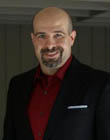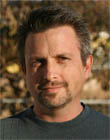|
|
This topic comprises 2 pages: 1 2
|
|
Author
|
Topic: Only widescreens left now?
|
|
|
|
|
|
|
|
|
|
|
|
|
Monte L Fullmer
Film God

Posts: 8367
From: Nampa, Idaho, USA
Registered: Nov 2004
|
 posted 12-31-2008 08:28 PM
posted 12-31-2008 08:28 PM




Sometimes, it's the director's choice on what lens to use in his movie. EXAMPLE: "Valkyrie" was shot in 1.85:1 since Brian Singer, the director, wanted to film in this ratio.
Also, with shooting flat, you have a good Field of Focus since the lens is capturing everything in a normal prospective.
Also, some directors also choose to shoot in Super35, which is also using the flat lens but using the entire frame of the film-including the soundtrack area, and the labs extract the Scope imagery from this negative. Good example is James Cameron's "True Lies" - entire film was shot in Super35, and the labs made excellent results in the scope release prints.
-Monte
| IP: Logged
|
|
Scott Norwood
Film God

Posts: 8146
From: Boston, MA. USA (1774.21 miles northeast of Dallas)
Registered: Jun 99
|
 posted 12-31-2008 09:29 PM
posted 12-31-2008 09:29 PM





Super-35 can be used to produce 1.85:1 release prints (or any other aspect ratio) as well, but that is almost never done. Actually, it would make a lot of sense for a film that would go through a digital intermediate, as it would give extra image area on the negative.
Also, anything shot in 16mm and blown up will usually be composed for 1.33 or 1.37. Films shot in super-16 are usually composed for 1.66 or 1.85. Video-originated material is usually 1.33, 1.37, 1.75, or 1.85. Remember that not all theatrical motion pictures are shot in 35mm.
For low-budget films, there are some practical considerations that make anamorphic cinematography more difficult: the lenses cost more to rent (and are larger, which makes it more difficult to shoot handheld or in tight spaces), more lighting is typically required, sets often need to be larger, and focus is more critical.
I'm not a big fan of the 1.85:1 format, personally; I would prefer that most films be either 1.37 or scope, but there are good reasons why the format is commonly used.
In the US, (almost?) every 35mm venue can show 1.85 and scope. Art houses and other non-multiplex theatres usually have 1.33 (silent), 1.37, and 1.66 as well. Other formats (1.75, 2.55 mag scope, etc.) are less common.
| IP: Logged
|
|
|
|
|
|
|
|
|
|
|
|
|
|
|
|
|
|
All times are Central (GMT -6:00)
|
This topic comprises 2 pages: 1 2
|
Powered by Infopop Corporation
UBB.classicTM
6.3.1.2
The Film-Tech Forums are designed for various members related to the cinema industry to express their opinions, viewpoints and testimonials on various products, services and events based upon speculation, personal knowledge and factual information through use, therefore all views represented here allow no liability upon the publishers of this web site and the owners of said views assume no liability for any ill will resulting from these postings. The posts made here are for educational as well as entertainment purposes and as such anyone viewing this portion of the website must accept these views as statements of the author of that opinion
and agrees to release the authors from any and all liability.
|

 Home
Home
 Products
Products
 Store
Store
 Forum
Forum
 Warehouse
Warehouse
 Contact Us
Contact Us




 Printer-friendly view of this topic
Printer-friendly view of this topic















